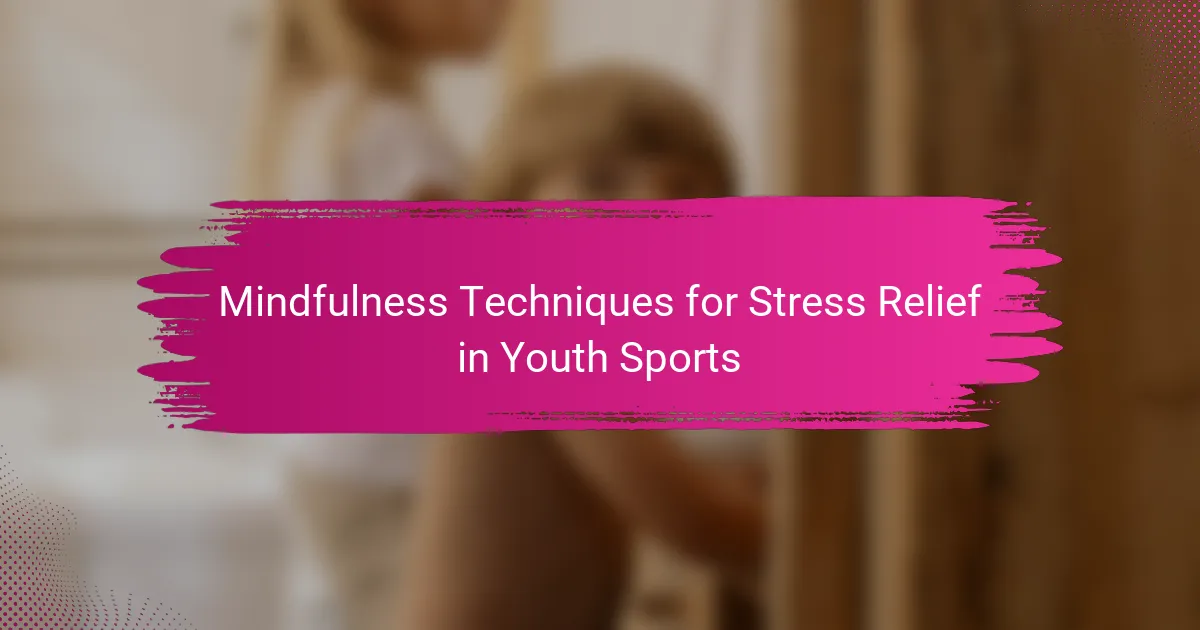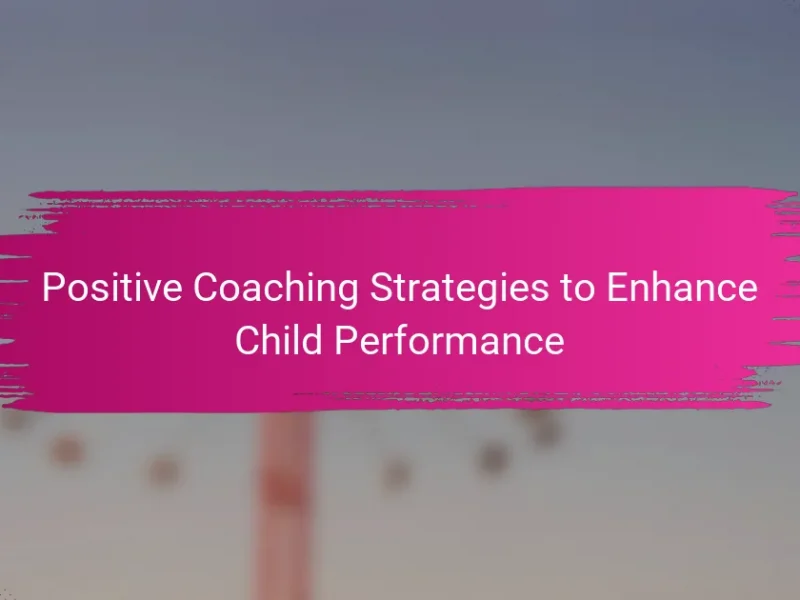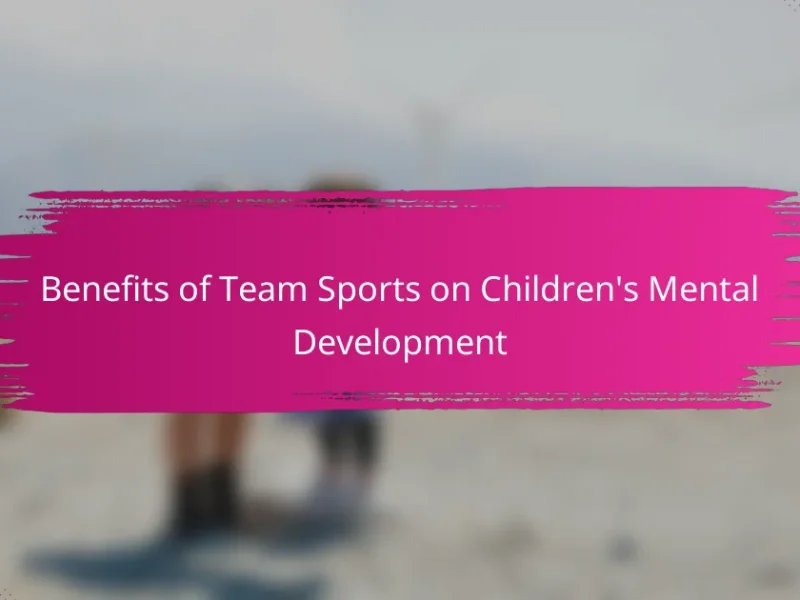Young athletes often face significant stress that can impact their performance and enjoyment of sports. Mindfulness techniques, such as deep breathing, visualization, and body scanning, can effectively manage this stress. These practices enhance focus, emotional regulation, and overall well-being. Implementing mindfulness in training sessions promotes resilience and prepares athletes to cope with competitive challenges.
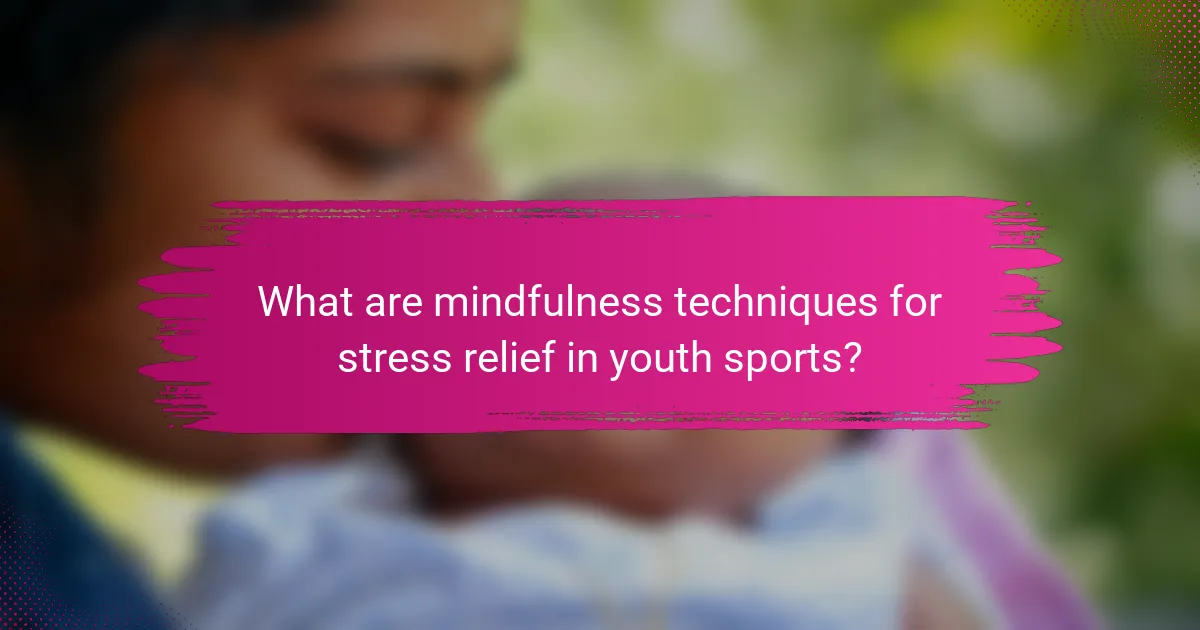
What are mindfulness techniques for stress relief in youth sports?
Mindfulness techniques for stress relief in youth sports include deep breathing, visualization, and body scanning. These practices help young athletes manage stress and enhance focus.
Deep breathing involves taking slow, controlled breaths to reduce anxiety and improve concentration. Visualization can enhance performance by imagining successful outcomes. Body scanning promotes awareness of physical sensations, aiding relaxation and stress management.
Implementing these techniques regularly can lead to improved mental resilience and overall well-being in young athletes.
How does mindfulness help young athletes manage stress?
Mindfulness helps young athletes manage stress by promoting focus and emotional regulation. Techniques such as deep breathing and visualization enhance performance and reduce anxiety. Research indicates that mindfulness can lower cortisol levels, which are linked to stress. Regular practice fosters resilience, allowing athletes to handle competitive pressures effectively.
What are the core mindfulness techniques used in youth sports?
Mindfulness techniques in youth sports include breath awareness, body scanning, visualization, and mindful movement. These practices help athletes manage stress and enhance focus. Breath awareness encourages players to control their breathing during high-pressure situations, promoting calmness. Body scanning involves tuning into physical sensations, aiding in relaxation. Visualization allows athletes to mentally rehearse performances, boosting confidence. Mindful movement integrates awareness into physical actions, improving coordination and presence. These techniques collectively support emotional regulation and performance under pressure.
How can breathing exercises be integrated into training?
Breathing exercises can be seamlessly integrated into training by incorporating them into warm-up and cool-down routines. These exercises enhance focus and reduce anxiety, crucial for youth athletes. For example, using deep diaphragmatic breathing before practice can improve performance and mental clarity. Additionally, short breathing breaks during training sessions can help athletes reset and maintain composure, fostering a mindful training environment.
What role does visualization play in performance enhancement?
Visualization significantly enhances performance by improving focus and reducing anxiety. Athletes who practice visualization can mentally rehearse their techniques and strategies, leading to better execution during competitions. This technique fosters a positive mindset, reinforcing confidence and motivation. Research indicates that mental imagery can activate similar brain regions as physical practice, enhancing skill retention and performance under pressure.
How can body scan techniques reduce anxiety?
Body scan techniques can significantly reduce anxiety by promoting mindfulness and enhancing body awareness. These techniques encourage individuals to focus on physical sensations, which can help ground them in the present moment. As a result, youth athletes can alleviate stress and anxiety associated with performance pressure.
Research indicates that regular practice of body scan meditation leads to lower anxiety levels and improved emotional regulation. This technique serves as a unique attribute of mindfulness practices, allowing young athletes to develop coping strategies that enhance their overall mental well-being.
Incorporating body scan techniques into training routines can foster resilience and improve focus during competitions. By cultivating a mindful approach, athletes can better manage their emotions, leading to enhanced performance and enjoyment in their sport.
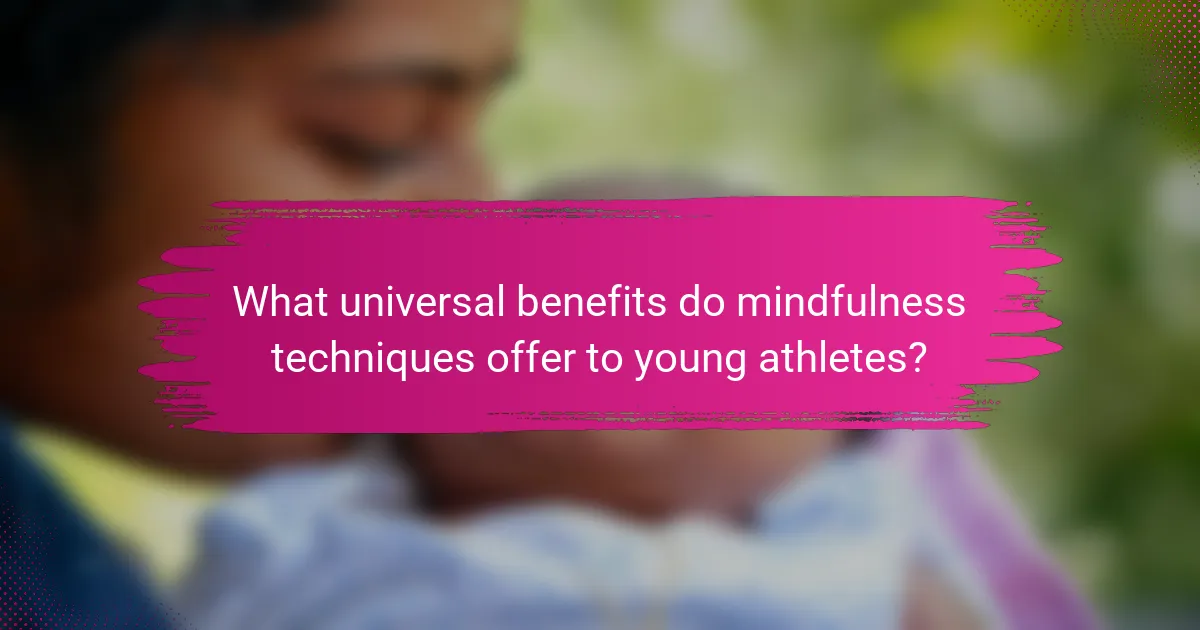
What universal benefits do mindfulness techniques offer to young athletes?
Mindfulness techniques offer young athletes improved focus, emotional regulation, and reduced stress. These benefits enhance performance and overall well-being. Research indicates that practicing mindfulness can lead to a 20% increase in concentration during competitions. Additionally, athletes report lower anxiety levels, which positively impacts their game. Mindfulness fosters resilience, enabling youth to cope with challenges effectively. By integrating these techniques, young athletes can achieve a balanced mindset, ultimately enhancing their sports experience.
How can mindfulness improve focus and concentration in sports?
Mindfulness enhances focus and concentration in sports by promoting mental clarity and reducing distractions. Techniques like deep breathing and visualization help athletes stay present, improving performance. Studies show that athletes practicing mindfulness report higher levels of concentration, leading to better decision-making and execution during competitions. This unique attribute of mindfulness creates a mental edge, particularly beneficial in high-pressure situations.
What impact does mindfulness have on emotional regulation?
Mindfulness significantly enhances emotional regulation in youth sports by promoting self-awareness and reducing stress. Techniques such as focused breathing and body scans help athletes recognize their emotions. This recognition allows for better responses to stressors, improving overall performance. Research indicates that mindfulness practices can lead to a 30% reduction in anxiety levels, enhancing emotional resilience.
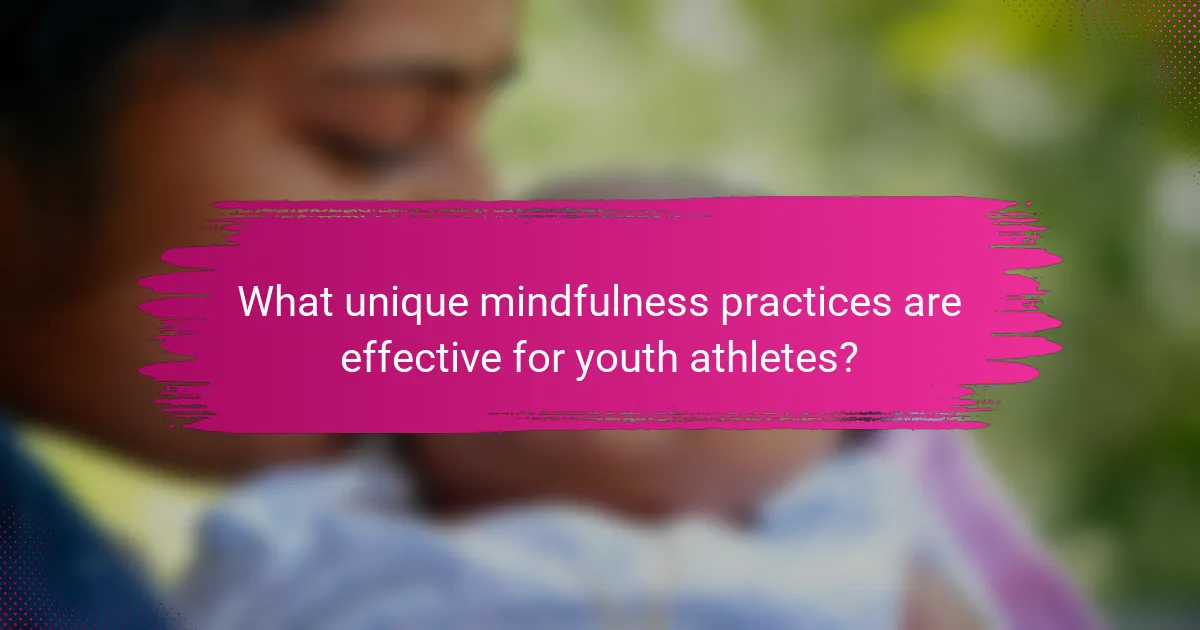
What unique mindfulness practices are effective for youth athletes?
Mindfulness practices such as breath awareness, body scanning, and visualization are effective for youth athletes. These techniques help manage stress and enhance focus during competition. Breath awareness encourages athletes to concentrate on their breathing, promoting relaxation. Body scanning allows athletes to recognize and release tension in their muscles. Visualization techniques enable them to mentally rehearse successful performances, boosting confidence. Incorporating these practices into training routines can improve overall mental resilience.
How can sports-specific mindfulness techniques be tailored for different age groups?
Sports-specific mindfulness techniques can be adapted for different age groups by considering their developmental stages and cognitive abilities. For younger athletes, techniques like simple breathing exercises and visualization can enhance focus and reduce anxiety. As athletes mature, more complex strategies such as mindful movement and self-reflection become effective. Tailoring techniques ensures relevance and effectiveness, fostering better performance and emotional resilience across age groups.
What are the unique challenges faced by youth athletes that mindfulness can address?
Mindfulness can help youth athletes manage performance anxiety, improve focus, and enhance emotional regulation. These challenges often arise from competitive pressure and social expectations. Mindfulness techniques, such as breathing exercises and visualization, can foster resilience and promote mental well-being. As a result, athletes may experience reduced stress and improved overall performance.
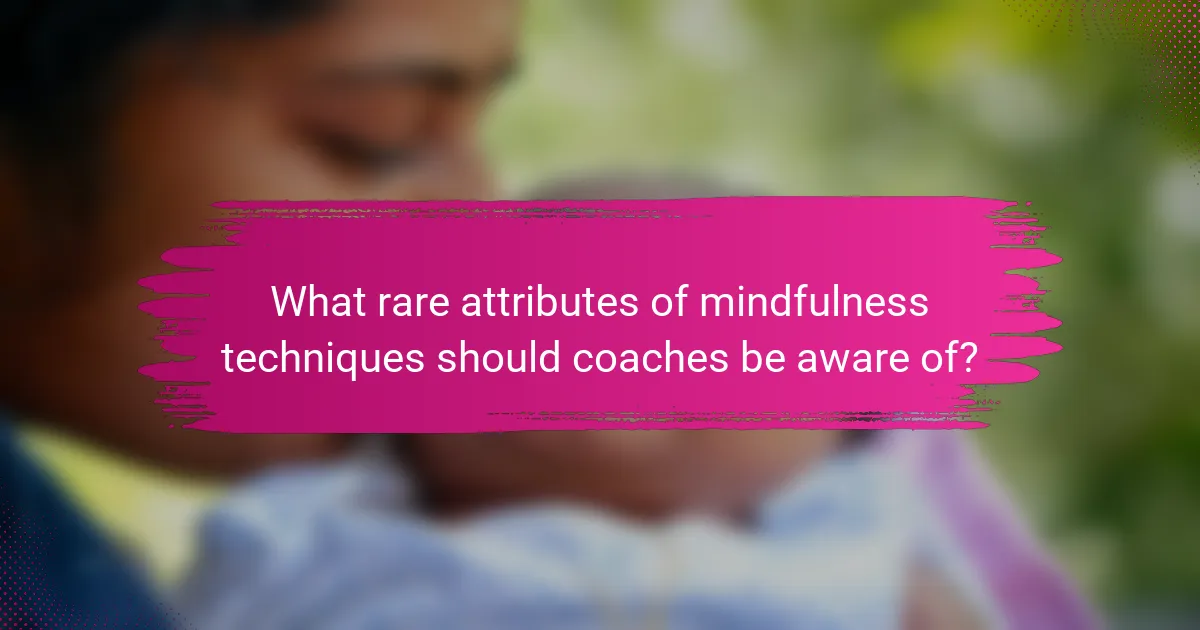
What rare attributes of mindfulness techniques should coaches be aware of?
Coaches should be aware that rare attributes of mindfulness techniques include personalized approaches, cultural adaptations, and integration with physical training. These unique aspects can enhance engagement and effectiveness in youth sports. For instance, tailoring mindfulness practices to individual athletes’ needs can lead to improved focus and emotional regulation. Additionally, incorporating cultural elements can foster a deeper connection and relevance to diverse youth participants. Lastly, blending mindfulness with physical training can create a holistic development environment, promoting both mental and physical well-being.
How can cultural differences influence the adoption of mindfulness in youth sports?
Cultural differences significantly influence the adoption of mindfulness in youth sports by shaping attitudes, beliefs, and practices. For instance, cultures that prioritize individual achievement may emphasize competitive mindfulness techniques, while collectivist cultures might focus on group cohesion and shared experiences. These varying perspectives can affect how mindfulness is taught and practiced within youth sports programs. Additionally, cultural values regarding mental health and emotional expression can impact youth receptiveness to mindfulness practices, influencing their overall effectiveness.
What uncommon mindfulness practices have shown promise in youth sports?
Uncommon mindfulness practices that have shown promise in youth sports include forest bathing, body scanning, and mindful walking. These techniques enhance focus, reduce anxiety, and improve overall performance. Research indicates that forest bathing, or immersing oneself in nature, can significantly lower stress levels in young athletes. Body scanning promotes body awareness and relaxation, helping athletes manage tension. Mindful walking encourages presence and grounding, which can enhance mental clarity during competitions. These practices provide unique approaches to integrating mindfulness into youth sports, fostering both mental and emotional resilience.
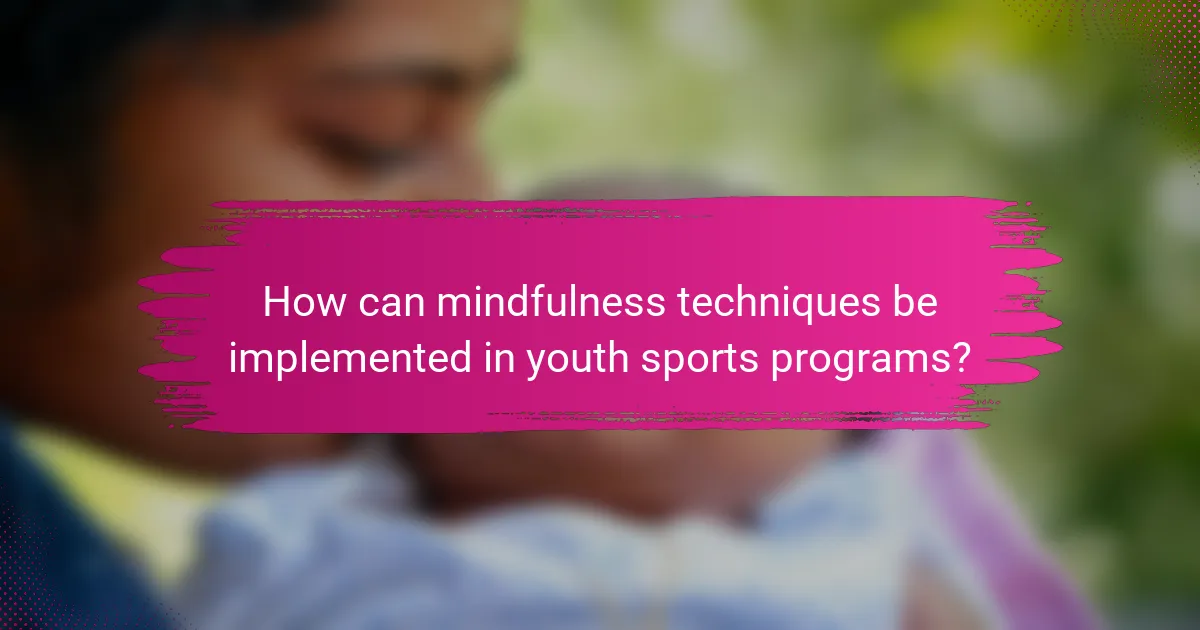
How can mindfulness techniques be implemented in youth sports programs?
Mindfulness techniques can be effectively implemented in youth sports programs by integrating short, focused practices into training sessions. Techniques such as guided breathing exercises, body scans, and visualization can help athletes manage stress and enhance performance.
Incorporating mindfulness into warm-ups can set a positive tone for practice, allowing young athletes to center their thoughts. For example, a five-minute breathing exercise before a game can reduce anxiety and improve focus.
Coaches can also encourage mindfulness during gameplay by prompting athletes to stay present and aware of their surroundings. This practice fosters resilience and emotional regulation, crucial for competitive environments.
Regularly scheduled mindfulness workshops can further reinforce these techniques, providing tools for athletes to use both on and off the field. This holistic approach supports mental well-being and enhances overall athletic performance.
What are the best practices for teaching mindfulness to young athletes?
To effectively teach mindfulness to young athletes, incorporate engaging and age-appropriate techniques. Start with short, focused breathing exercises to promote relaxation and concentration. Use guided imagery to help athletes visualize success and manage anxiety. Introduce mindfulness games that encourage awareness of thoughts and feelings, making the practice enjoyable. Regular practice during training sessions can enhance performance and resilience.
What common mistakes should coaches avoid when introducing mindfulness?
Coaches should avoid common mistakes such as lack of clarity, insufficient training, and neglecting individual needs when introducing mindfulness. Clear communication about mindfulness benefits is crucial. Coaches should receive proper training to effectively guide youth. Additionally, personalizing mindfulness practices ensures they resonate with each athlete, enhancing engagement and effectiveness.
How can parents support mindfulness practices at home?
Parents can support mindfulness practices at home by integrating simple techniques into daily routines. Encourage breathing exercises during stressful moments to help children manage anxiety. Create a quiet space for meditation or reflection, fostering a calming environment. Incorporate mindful activities, such as yoga or nature walks, to enhance awareness and connection. Regularly practice gratitude discussions to promote positive thinking and emotional resilience. These strategies can significantly enhance youth sports performance by reducing stress and improving focus.
What resources are available for coaches to learn more about mindfulness techniques?
Coaches can access various resources to learn mindfulness techniques for stress relief in youth sports. Recommended resources include online courses, books, workshops, and webinars focused on mindfulness practices. Notable platforms like Mindful Schools and the Center for Humane Technology offer valuable training programs. Additionally, research articles and journals provide insights into the effectiveness of mindfulness in sports settings. Engaging with these resources equips coaches with practical strategies to enhance youth athletes’ mental well-being.
